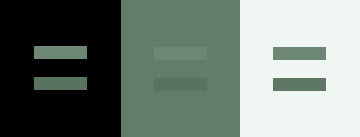 |
| Comparing light, dark and grey contrasts. http://facweb.cs.depaul.edu/sgrais/color_context.htm |
Another important part of Colour Contrast is when we look at people who are colour blind. (A topic I had a buddy write about once - Colour Blind Modellers.) You can convert 2 different colours to greyscale and they become the same grey, causing details to literally disappear. There are a bunch of websites dedicated to testing how well colours contrast.
When we paint miniatures, we want to make colours "pop". Try to remember:
Use Dark Shadows on lighter colours
The " = " sign appears darker against a light background
and lighter against a dark background.
http://facweb.cs.depaul.edu/sgrais/color_context.htm- This will cause the lighter areas of those colours to really stand out.
- The easiest way is using a wash.
- Use Light Highlights on darker colours.
- These highlights will stand out strong.
- The easiest way is to dry brush.
Surround dark details with lighter colours and vice versa.
Works for colours too.
http://facweb.cs.depaul.edu/sgrais/color_context.htm- Instead of using White and Black to create contrast, colours can have the same effect.
- This is best accomplished with versions of the same colour you're trying to highlight as using different colours can change the Context. (Which I'll cover lower.)
 |
| http://facweb.cs.depaul.edu/sgrais/color_context.htm |
Basically, (Without getting technical.) when two colours that are roughly the same intensity are next to each other, one can over power the other and cause us to interpret the smaller colour as a different Hue. This can also happen near certain greys as this website demonstrates.
 |
| http://facweb.cs.depaul.edu/sgrais/color_context.htm |
Some Painted Examples
Rather than paint a full miniature this week, I want to point a few things out on some miniatures I've already painted, since this is a rather unusual concept.
I painted the below miniature for a friend's roleplaying character with a request to have a wizard generally based on the animated Joker, There are a bunch of crazy colours going on here, so why does it work? Purple is the overall and both green and yellow are the split complementaries.
In the smaller photo, take a look at how some of the colours look when isolated and compared to others around them. Yellow seems stronger in stripes, but as the brain down his back, looks darker while surrounded by purple. The green trim seems bright against the purple, but darker surrounded by red.
In a miniature coming up when looking at greyscale, I used two different whites for basing and highlights. In the helmet, White Gesso was used to highlight his horns and P3 White was used on his helmet. Visualized apart, hard to tell, but side by side you can see the highlights are definitely different shades of white.


